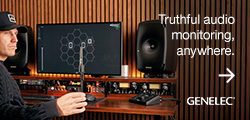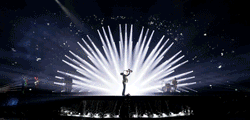![]() ‘I've worked in a lot of weird and wondrous sites, but it’s seldom one comes across a place quite like this,’ says sound artist Thor McIntyre-Burnie.
‘I've worked in a lot of weird and wondrous sites, but it’s seldom one comes across a place quite like this,’ says sound artist Thor McIntyre-Burnie.
He’s describing the wind tunnels that helped shape the Spitfire’s elliptical wings and guided the design of early supersonic aircraft. Now open to the public for the first time, the tunnels provide the setting and the acoustics for his Flying Into The Dawn sound installation.
Adopted by a company called Artliner as a pop-up installation and art/exhibition space, the Farnborough Wind Tunnels’ two buildings (Q121 and R52) provide a strong wartime link for Flying Into The Dawn.
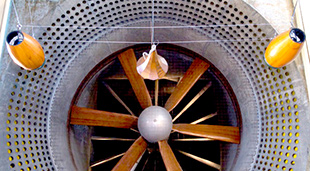 The first outside broadcast ever made by the BBC, the Nightingale broadcasts were duets between the cello of Beatrice Harrison (the leading cellist of her generation and a favourite of composers including Delius and Elgar) and a nightingale that regularly accompanied her practice sessions in her garden. With the backing of Lord Reith himself, BBC engineers brought equipment to the countryside to make an initial recording that attracted a million listeners when first aired in 1924.
The first outside broadcast ever made by the BBC, the Nightingale broadcasts were duets between the cello of Beatrice Harrison (the leading cellist of her generation and a favourite of composers including Delius and Elgar) and a nightingale that regularly accompanied her practice sessions in her garden. With the backing of Lord Reith himself, BBC engineers brought equipment to the countryside to make an initial recording that attracted a million listeners when first aired in 1924.
The recordings became a regular event until halted in 1942 when the engines of Wellington and Lancaster bombers on their way to bomb Mannheim were inadvertently picked up by the Marconi-Sykes Magnetophone microphone deployed by the BBC team, led by engineers PP Eckersley and AGD West – arousing fears that German listeners may use them to gain intelligence about the RAF’s operations. The original recording, however, still exists today.
The dawn of sound
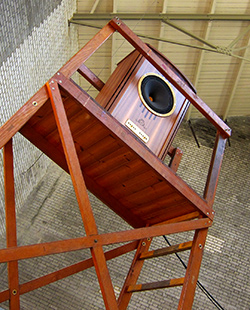 ‘My work is about the context, site, materials, light, functions and experience,’ McIntyre-Burnie offers. ‘It’s about working with and responding to a particular space and creating interventions that can reawaken a place with an alternate function. Sound has an uncanny ability to transform our relationship with a space, and when spatially dispersed becomes an experience to explore, by walking within. It’s this interplay between the physical and invisible realms that fascinates me.’
‘My work is about the context, site, materials, light, functions and experience,’ McIntyre-Burnie offers. ‘It’s about working with and responding to a particular space and creating interventions that can reawaken a place with an alternate function. Sound has an uncanny ability to transform our relationship with a space, and when spatially dispersed becomes an experience to explore, by walking within. It’s this interplay between the physical and invisible realms that fascinates me.’
Flying Into The Dawn begins with the nightingale recording from 1942 emanating from a sculpture in place of an aircraft being tested: ‘We hear the recording from the day the live broadcast was cut, when they accidentally picked up the sound of a whole fleet of WWII bombers flying overhead,’ McIntyre-Burnie says. ‘This source then interplays with more ethereal voices emanating from speakers hidden within the return tunnel – the voices are local people, many of whom used to work here.’
To create his work, McIntyre-Burnie has exploited the unusual acoustics of the buildings and explored the historical link with the wind tunnels’ wartime loudspeaker system by turning to Tannoy for more modern loudspeaker technology.
‘I like the idea of the old original Tannoy horns still affixed to the walls here conversing with their latest heavyweight offspring,’ he says. ‘These horns are very much a part of this pivotal period of history, they are what made Tannoy a noun in our lexicon, like Hoover – they are what gave voice to Winston Churchill’s infamous public address.’
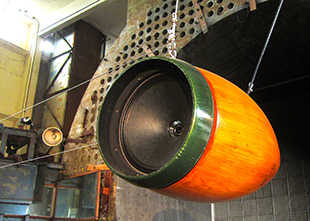 Playback in Q121 is from a Tascam HD24 recorder via two Tannoy VX12HP loudspeakers built into engine-like cylinder cabinets suspended in the wind tunnel. There is also a gramophone horn assembly with an unbranded 2-inch driver. In the Return Hall, three Tannoy VXP8 speakers play out the voices.
Playback in Q121 is from a Tascam HD24 recorder via two Tannoy VX12HP loudspeakers built into engine-like cylinder cabinets suspended in the wind tunnel. There is also a gramophone horn assembly with an unbranded 2-inch driver. In the Return Hall, three Tannoy VXP8 speakers play out the voices.
‘Q121 is a fascinating place for sound, as it is all architecturally designed to funnel air around as efficiently as possible and reduce any turbulence – and this does very interesting things to the passage of sound,’ McIntyre-Burnie says. ‘Here, I purpose-built a suspended sculptural rig in place of the test plane, projecting sound and focus back into the tunnel.’
Alongside Q121 is the R52 wind tunnel, which contains three separate spaces where McIntyre-Burnie explores ‘a moment of anechoic silence’, marrying film of the latest research into nano insect drone technology with the growl of the Farnborough Symphony Orchestra’s bass player before moving on to a homage to birds and the possibility of ‘flying for the thrill of it’.
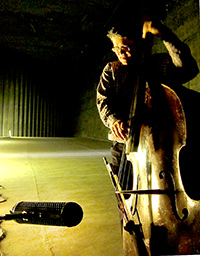
R52 was kitted out with a seven-channel sound set-up to explore the ‘darker sides’ of the research facility: ‘This space has a very different feel to the cathedral-like qualities of Q121,’ McIntyre-Burnie says. ‘I felt like it needed a form of palate cleanser. In the first space there are these lovely anechoic alcoves; here I worked with lighting designer comapny BKKR and food artist Carolyn Hobkins to create a moment to savour the acoustic qualities of these alcoves.
‘The second room houses an equally astounding piece of engineering in a wooden tunnel. Within this I’ve created a four-channel mix using Tannoy Precision 6.4s with their lovely bottom end, video projection and three-channel exterior atmosphere. Part of this composition included recording the bass player from the FSO playing his fifth string [down to 30Hz] within the Q121 wind tunnel and its phenomenal acoustics.’
This recording called on a stereo pair of Audio-Technica AT3032s as main mics, Sennheiser MKH 60s for room reflections and a distant pair of Sennheiser MKH 406 mics. ‘I like the idea of this wooden structure awakened like a giant instrument and exploring the edge of breath and a note. He offers his own interpretation of the arc of the bombers…’
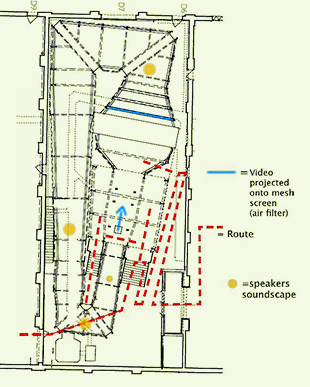 The final room uses four Tannoy Prestige range loudspeakers, including the Canterbury, as both sculptural and acoustic pieces. Mounted on original wooden aircraft inspection towers, they are arranged so that they disrupt the quadraphonic circle and encourage people to listen through the architecture instead. ‘Any physical structure introduced becomes a sculpture, even the cables become part of the sculptural form,’ McIntyre-Burnie says. ‘These hand-built Tannoy speakers, sitting astride these old inspection towers salvaged from Q121, represent the forefront of their acoustic research – and, thankfully, Tannoy agreed to loan them to me.
The final room uses four Tannoy Prestige range loudspeakers, including the Canterbury, as both sculptural and acoustic pieces. Mounted on original wooden aircraft inspection towers, they are arranged so that they disrupt the quadraphonic circle and encourage people to listen through the architecture instead. ‘Any physical structure introduced becomes a sculpture, even the cables become part of the sculptural form,’ McIntyre-Burnie says. ‘These hand-built Tannoy speakers, sitting astride these old inspection towers salvaged from Q121, represent the forefront of their acoustic research – and, thankfully, Tannoy agreed to loan them to me.
‘They are turned so they explore the reflections of the space, conversing with the walls, panels, windows and old relics of themselves. The idea is to encourage people to listen through the architecture.
‘Surrounding the tunnel we hear a four-mic spatial recording of a starling bird roost site, just after dawn, stirring the air of the hanger without. The piece uses recordings I made in the former Brighton West Pier concert hall with Chris Watson (David Attenborough’s sound man), when it was a massive starling roost prior to its collapse into the sea. Studying their murmuration flight and morphing this with a sonic study of its sister pier’s roller coaster, asking the question, “do birds ever fly simply for the thrill of it?”
See also:
Recording the ‘Ice Whisper’ (Arts recording project by Juergen Staack)
Meyer Sound dives into immersive art installation (Sound installation by Jana Winderen)
More: www.tannoy.com
More: www.aswarm.com





